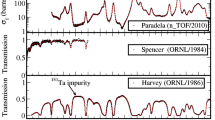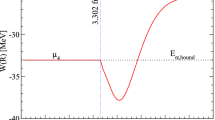Abstract
The k0-method (De Corte in The k0-standardization method: move to the optimization of neutron activation analysis. Habil. Thesis, Ghent University, Belgium, 1987) was developed solely for the use of (n, γ) nuclear reactions in neutron activation analysis. For this, a definition of only the thermal and epi-thermal flux was needed. The fast flux of the fission neutrons was not taken into account although it was considered for primary interferences by De Corte0. The energy distribution of the fission neutrons can be rather well described by a Watt distribution but is reactor dependent. To complicate things, the activation cross-section behaviour is nuclide dependent. In order to incorporate threshold reactions in the k0-method we propose to use predefined kf-factors, measuring the fast flux using a Ni-58 monitor, and to introduce an h-factor that accounts for all deviations for a specific reaction and irradiation facility. It is shown, based on data from Verheijke, that there are useful correlations for Ni-58, Ti-47 and Ti-48. Activation cross section functions indicate that there are possible more relations that might allow h-factors to be predicted.






Similar content being viewed by others
References
De Corte F (1987) The k0-standardization method: move to the optimization of neutron activation analysis. Habil. Thesis, Ghent University, Belgium
Verheijke ML (1992) Ph.D. Thesis, Instrumental neutron activation analysis developed for silicon integrated circuit technology, Delft, The Netherlands
Durham RW, et al (1962) Threshold reaction interference in neuron activation analysis. CRDC-1070, AECL-1434, Chalk River, Ontario, Canada
Chadwick MB et al (2011) ENDF/B-VII.1 nuclear data for science and technology: cross sections, covariances, fission product yields and decay data. Nucl Data Sheets 112–12:2887–2996
Freeman NJ, Barry JF, Campbell NL (1969) The (n, α) cross sections for natural nickel, iron, chromium and molybdenum in a fission neutron spectrum. J Nucl Energy 23:713–721
Erdtmann G (1976) Neutron activation tables (Kernchemie in Einzeldarstellungen; Vol. 6) ISBN 3-527-25693-8
IAEA (1974) Handbook on nuclear activation cross sections. Technical Report 156
Uddin MS, Sudár S, Hossain SM, Khan R, Zulquarnain MA, Qaim SM (2013) Fast neutron spectrum unfolding of a TRIGA Mark II reactor and measurement of spectrum-averaged cross sections: integral tests of differential cross sections of neutron threshold reactions. Radiochim Acta 101:613–620
Author information
Authors and Affiliations
Corresponding author
Ethics declarations
Conflict of interest
This paper does not incur potential conflicts of interest. No human test subjects or animals played a part.
Additional information
Publisher's Note
Springer Nature remains neutral with regard to jurisdictional claims in published maps and institutional affiliations.
Appendix 1: Interference corrections factors based on k f’s
Appendix 1: Interference corrections factors based on k f’s
Interference reactions can be split in two types:
-
1.
(n, p), (n, α) reactions on target elements (b) that result in a product that also is formed by an (n, γ)-reaction on element (a).
-
2.
(n, n’), (n, 2n) reactions where the target nuclide is one of the natural occurring nuclides of the element under activation and the product is the same as formed by the (n,γ)-reaction.
Correction for threshold reaction interferences of type 1, when the concentration of the interfering element, cb, is known becomes:
With correction factor for interference:
Correction for threshold reaction interferences of type 2, when the interfering element is the analyte itself and thus unknown, becomes:
The type 2 reaction that can interfere the standard k0 (n, γ)-reaction most is (n, n’), however (n, 2n) can also be of importance. The most important produced isotopes are Se-77 m, Sr-87 m, Cd-111 m, Sn-117 m, Ba-135 m and Ba-137 m, of which Sn-117 m is causing a serious interference up 50% and more. The proposed kf’s for most interfering reactions are given in Table 1.
Rights and permissions
Springer Nature or its licensor (e.g. a society or other partner) holds exclusive rights to this article under a publishing agreement with the author(s) or other rightsholder(s); author self-archiving of the accepted manuscript version of this article is solely governed by the terms of such publishing agreement and applicable law.
About this article
Cite this article
van Sluijs, R., Blaauw, M. Defining “kf-factors” for threshold reactions. J Radioanal Nucl Chem 332, 1835–1840 (2023). https://doi.org/10.1007/s10967-023-08871-y
Received:
Accepted:
Published:
Issue Date:
DOI: https://doi.org/10.1007/s10967-023-08871-y




